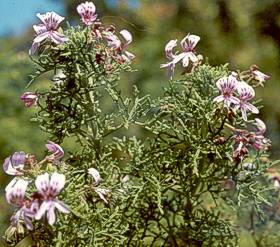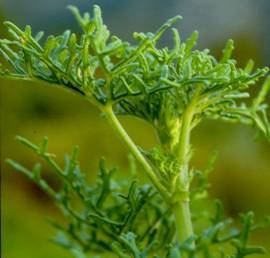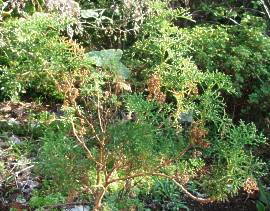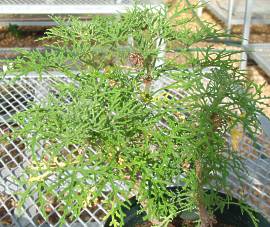Pelargonium radens
Pelargonium radens H.E.Moore
Family: Geraniaceae
Common names: rasp-leaved, multifid-leaved pelargonium
Introduction
This showy, scented pelargonium will bring delight to any fragrant garden.

Description
Description
Pelargonium radens is an erect, closely branched shrub which is usually less than 1.5 m high. The younger braches remain herbaceous and slender but become woody at the base with age. These branches are also covered with stiff bristles which make them rough to the touch. The extremely divided leaves are triangular in shape and are 30-50 x 30-60 mm. The leaves have a pungent odour when they are bruised. The flowers are pale purple to pink with deep purple markings on the upper two flower petals. The plant flowers from August to January. The seeds are set immediately after its flowering period.

Conservation Status
Status
Pelargonium radens is very common and therefore has no conservation status.

Distribution and habitat
Distribution description
Pelargonium radens occurs in the southern and eastern Cape, near Barrydale eastwards to Engcobo. It is generally found in ravines or kloofs near streams or among shrubs on mountainsides.
Derivation of name and historical aspects
History
The genus Pelargonium belongs to the family Geraniaceae, a large family of 11 genera and 800 species in the subtropical and tropical world. There are 270 species of Pelargonium which occur in S, E and NE Africa, Asia, St Helena, Tristan da Cunha, Madagascar, Australia and New Zealand ; 219 species occur in southern Africa.
The genus Pelargonium derives its name from the resemblance of the shape of the fruit to the beak of a stork, pelargos in Greek. The species name radens (Latin) which refers to scraping or radula (Latin) rasp or file, refers to the rasp-like leaves. Pelargonium radens was introduced into England in 1774. This is commonly known as Pelargonium radula, but Prof. H.E. Moore (1955) pointed out that this name was superfluous when published and was therefore rejected. Multifid refers to the number of deeply divided lobes on the leaf.
Ecology
Ecology
The seed of Pelargonium is quite interesting in that attached to the elliptically shaped seed, is a feathered, tail-like structure that is coiled in a spiral. The tail allows the seed to drill and secure itself in the soil if twisted around by the wind or affected by the movement of animals.
Uses
Use
Pelargonium radens is one of the parent plants which hybridizes with P. capitatum to form the rose-scented pelargonium hybrid. This hybrid is one of several species that are used for essential oils. The cultivar, Rose, was thought to be derived from P. graveolens but it was later discovered that it originated from the hybrid between P. capitatum and P. radens. The components which give the characteristic rose scent to geranium oil (citronellol, geranoil, linalool and nerol) occur best in trace quantities in P. radens and P. graveolens.
Growing Pelargonium radens
Grow

Pelargonium radens can easily be grown from seeds and cuttings. Cuttings can be grown at any time of the year. Take semi-mature stem cuttings and apply a rooting hormone to it to stimulate the rooting process. Dip the basal ends in a rooting hormone, and insert into a prepared hole made by a dibber or a nail to avoid damaging the ends. Place the cuttings in a coldframe to root. Rooting of this species usually takes about 3 weeks. Once the cuttings have rooted, pot them in a well-drained potting soil mix. Feed the newly rooted cuttings with a liquid seaweed-based fertilizer.
Pelargoniums can also be grown from seed in late summer and early autumn. Sow the seeds in a light, well-drained potting soil. Broadcast the seeds evenly in the seed tray, covering them with a layer of clean white sand. The depth of sowing is usually one-and-a-half times the size of the seed. Water thoroughly but gently and provide light shade. Germination usually takes place within 3 weeks. Pelargoniums grown from seed are generally more vigorous than those made from cuttings; however, they take longer to flower. Remember that plants grown from seed will show some degree of variation and if a particular form or variant is required, it must be propagated vegetatively. The plant can grow easily in a garden where the soils are fairly damp and moist. It is a relatively fast-growing, showy, long-flowering but relatively short-lived (5 years) perennial that brings spring colour to any mixed border. It can be used as a bedding plant to create a dense band of colour. It also does very well in containers or pots.
References
- Goldblatt, P. & Manning, J. 2000. Cape plants. A conspectus of the Cape flora of South Africa. Strelitzia 9. National Botanical Institute, Cape Town and Missouri Botanical Garden.
- Van der Walt, J.J. 1977. Pelargoniums of southern Africa. Purnell, Cape Town.
- Usher, G. 1979. A dictionary of botany. Constable, London.
- Van Wyk, B-E. & Gericke, N. 2000. People's plants. Briza Publications, Pretoria.
Credits
Trevor Adams
Kirstenbosch National Botanical Garden
August 2008
Plant Attributes:
Plant Type: Shrub
SA Distribution: Eastern Cape, Western Cape
Soil type: Sandy, Loam
Flowering season: Spring, Early Summer, Winter
PH: Acid, Neutral
Flower colour: Purple
Aspect: Full Sun
Gardening skill: Easy
Special Features:
Horticultural zones










Rate this article
Article well written and informative
Rate this plant
Is this an interesting plant?
Login to add your Comment
Back to topNot registered yet? Click here to register.